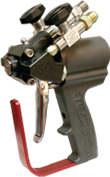Recent Posts
Categories
Whether you’re building a new home or thinking of reinsulating your existing house – there are many factors to consider before you start your project. What insulation method will yield the best results? How much insulation do you need? Where should you insulate? Spray foam insulation offers a true R-Value of 6.0 (with 1 inch thickness) and can reduce your energy costs significantly. Before you start your insulation project, talk to the experts at Spray On Systems Winnipeg for a consultation.
- Attic Insulation
- attic
- insulation winnipeg
- basment insulation winnipeg
- Insulating Your Attic
- insulation for the home
- attic insulation winnipeg
- spray foam insulation winnipeg
- spray insulation
- spray insulation winnipeg
- Sprayed Insulation
- Sprayed Insulation Winnipeg
- Winnipeg spray foam
- winnipeg spray foam installers
- winnipeg spray foam insulators
There’s a simple answer to this question. R-value is the numerical representation of what insulative factors different types of insulation contain. But just like a number that describes what place you have waiting in line, it leaves out the most of the important parts about who you are. R-value is used to describe the insulative effects of insulation, but it leaves out the most important parts of the process like air penetration, condensation and other natural effects that occur in the real world. That’s why R-values are often a misleading number.
Fiber Insulation
When R-values were first conceived, the majority of insulation materials were made from cellulose, Rockwool or fiberglass—fiber-based materials. Defined by the American Society for Testing and Materials (ATSM), R-values often are biased towards fiber insulation and give very little effort into the effects the a solid based insulation like spray foam have on a home in a real world environment. For instance, if a fiber-based insulation with an R-value of 20 gets wet, its R-value is reduced to zero. R-values are determined in a lab and aren’t subjected to real world conditions like air penetration or moisture, ensuring a misleading number is applied to the insulative material.
Air Loss
One of the biggest problems with misleading R-values is air penetration or loss. Every structure in the world losses or gains air as the structure ventilates. Outside air temperatures and inside temperature differences ensure that air movement through walls, floors and ceilings takes place. This makes fiber materials that aren’t sealed properly have a lower R-value than described by the ATSM. Sealed insulations like closed cell polyurethane foam have the highest true R-value because they seal out air penetration and prevent conditioned air from escaping the structure. These materials work especially well in attics and flooring because air movement occurs more actively vertically than horizontally.
- spray insulation winnipeg
- Winnipeg spray foam
- winnipeg spray foam installers
- blow-in insulation winnipeg
- r value
- r value of spray foam
- r value spray foam
- r value spray foam insulation
- r value statistics
- spray foam insulation R-Value
- spray foam R-Value
- spray foam vs blown in fiberglass
- spray insultion R-Value
- spray polyurethane foam
- winnipeg spray foam experts
- Winnipeg Spray insulators
Did you know? Spray On Systems is on Facebook! Like us to get the latest updates and spray insulation resources sent to your Facebook feed!
Click on the link below to visit our page:
- attic insulation winnipeg
- spray insulation winnipeg
- Winnipeg spray foam
- spray polyurethane foam
- basement insulation winnipeg
- blown-in insulation
- cabin insulation manitoba
- fibreglass insulation winnipeg
- insulation for basement
- spray foam insulation in winnipeg
- sprayed on insulation winnipeg
- winnipeg spray insulation
- Winnipeg sprayed on insulation
Whether you’re using your cargo van for work or for pleasure, when the cold weather of winter comes rolling into town, you can bet that a well-insulated cargo van is the only way to go. But most cargo vans don’t come with insulation. In fact, they’re usually no more insulated than a tin can. So what do you do to insulate your cargo van without costing you a fortune and your sanity? Use these tips for insulating a cargo van and stay comfortable in your van all year long.
Conventional Insulation
Whether it’s the conventional fiberglass insulation or rigid foam panels, many DIY cargo van insulation projects have failed miserably. The problem with many of these DIY projects is that the material used is inadequate for the job. More often than not, these materials will create heavy condensation when the space is heated or cooled. This process is the same effect that occurs when you have a glass filled with ice cubes and the exterior of the cup sweats water. This can easily happen inside of a DIY insulated cargo van. When moisture is trapped between the shell of the van and the insulation, mold and mildew can quickly form and ruin you insulation permanently.
Spray Foam Insulation
The best way to insulate a cargo van is by using a sprayed insulation. Spray foam works well as it bonds with the metal interior of the vehicle and doesn’t allow a space for water to condensate when temperatures differ greatly between the two materials. Polyurethane foam insulation can be applied easily and cost effectively—but only when it’s done right. While there are many DIY spray foam applications available; it’s not a good idea to do the job yourself. If you have a need for insulated cargo vans, forget about DIY. Spray on Systems has ability, experience and capacity to complete your cargo van insulation project quickly and cost effectively. You can trust that we will do it once and do it right for the perfectly insulated cargo van.
- box van truck winnipeg
- insulated trucks
- insulated vans
- insulated vans winnipeg
- insulating cargo vans
- insulating vans winnipeg
- insulation for cargo vans winnipeg
- insulation for trucks
- insulation for vans
- refrigerated trucks
- refrigerated trucks and vans
- refrigerated vans
- truck bedliners
- truck bedliners Winnipeg
- truck liners
- truck sprayed bedliners
- Winnipeg truck bedliners
- Winnipeg truck sprayed bedliners
Whether you’re building a new home or you’re thinking about reinsulating your old home, knowing where to begin can be difficult at best. What insulation system works best, how much do you need and what’s the most cost effective way to insulate are all important questions that should be answered long before you begin to consider insulating your structure. Use this guide to insulating your home and get the most out of your new insulation.
New Homes
Building a new home is the easiest way to insulate. But don’t just choose the cheapest insulation you can buy. R-values are used to determine the effects that insulation has on the structure. The higher the number, the better the insulation—or so they claim. R-values are tested in a lab and aren’t subjected to real world conditions like moisture and air penetration. Fiber based insulation will lose its R-value if it becomes wet or significant air penetration occurs. By using closed cell polyurethane spray foam, you can ensure that your homes R-value remains consistent, even when other materials don’t.
Existing Homes
Older homes weren’t built to the specifications of today’s modern day homes. Insulation wasn’t a big concern because energy costs were so low that it didn’t matter if the heater had to work harder to warm the structure. Today’s fuel prices are only going to become more costly, so many homeowners are choosing to reinsulate their home.
- Walls- Reinsulating existing walls can be easily done by either adding an additional interior wall to the structure, or by filling the voids the between the studs or brick using a spray foam insulation.
- Basements- It’s best to insulate the exterior walls of a basement because it also helps to relieve moisture problems that often plague basements. A rigid foam panel or extruded spray foam is used to cover the exterior walls.
- Attics- The most cost effective space to reinsulate, attics can be covered with more fiber insulation, batting or spray foam. Spray foam prevents air penetration that can lower R-values of other fiber-based insulation.
- insulation for the home
- attic insulation winnipeg
- spray foam insulation winnipeg
- spray insulation
- spray insulation winnipeg
- Winnipeg spray foam
- spray polyurethane foam
- Winnipeg Spray insulators
- basement insulation winnipeg
- insulation for basement
- spray foam insulation in winnipeg
- basement spray foam winnipeg
- garage insulation winnipeg
- home renovation
- new home insulation winnipeg
- Spray foam insulation
- spray foam winnipeg
When wintertime weather is in effect, being in a drafty home is more than uncomfortable. It’s going to cost much more to heat the structure. Even when it’s not cold outside, a poorly insulated house is susceptible to moisture problems and other troubles due to poor insulation. Use the following tips to ensure your insulation is up to par.
Cold Weather Insulation Warning Signals
- Evidence of Mold Growth
- Drafty Windows
- Exterior Walls are Cold to the Touch
- Flooring Materials are Cold
- Uneven Heating Distribution Throughout the Home
- Higher Energy Costs
Warm Weather Insulation Warning Signals
- Occasional Bursts of Warm Air
- Expensive Cooling Costs
- Air Conditioning System Runs Often
- Mold Growth in the Basement and Around Windows
- Some Rooms are Warmer than Others
Effective Insulation is the Key to Prepping your Home for Winter
While all insulation may seem the same, it’s certainly not. Some materials insulate better, while some are more cost effective. No matter what style of insulation you install, it’s very important that it’s installed properly to be as effective as possible. To do this, be sure that you follow these steps for effective insulation installation.
- Air Barriers- These prevent the movement of interior and exterior air through the home.
- Thermal Bridges- Structural members and other building materials that extend from the warm side to the cold side of the structure lower a home’s R-value. Reduce thermal bridges to maintain a consistent R-value.
- Fill all Cavities- Small gaps and spaces can make insulation ineffective. Fill all voids using a spray foam insulation to keep R-value consistent.
- Vapor Barrier- It’s very important to keep moisture out of the insulation system by installing a vapor barrier.
Is it Cost Effective to Insulate?
No matter how old your home is, it’s very important to keep it well insulated. In most cases, retrofitting an older home with new insulation is simple and cost effective when sprayed insulation is used to fill wall, attic and flooring cavities. Whether you have a new or older home, it’s cost effective to keep it well insulated.
- insulation winnipeg
- insulation for the home
- attic insulation winnipeg
- spray foam insulation winnipeg
- spray insulation winnipeg
- Winnipeg spray foam
- Winnipeg Spray insulators
- basement insulation winnipeg
- spray foam insulation in winnipeg
- basement spray foam winnipeg
- new home insulation winnipeg
- insulating for winter
- insulating home for winter
- insulation for winter
- prepare home for winter
- spray foam companies in winnipeg
- spray foam insulation for winter
- winterizing your cabin

Winterizing your cottage or cabin is a great way to prevent damages that cold winters can cause to a structure. Plumbing pipes need to be drained, appliances need to shut off and doors and windows should be properly sealed. While all this work is well worth the trouble, it’s not always necessary when you properly insulate your cabin. In fact, with the right insulation, you can enjoy your winter cabin year round. Use these tips to winterize your cabin and you’ll be sure to get the most out of your summer retreat.
What Needs to Be Insulated?
Your cabin needs to be well insulated to protect against the damages the wet and cold winters can cause. With an insulation system that has the right R-value, you can easily use your winter cabin all year long. The following areas of your cottage need to be well insulated to keep your cabin cozy throughout the seasons.
- Crawlspaces- These areas must be accessible and provide enough space to warrant insulation.
- Walls- Existing walls can be insulated easily using a polyurethane foam insulation injected in wall cavities.
- Attics- Rafters and attic spaces should be accessible as well. Spray foam insulation works well in these tough to insulate spaces.
- Basements- Vapor barriers are important in damp basements. Insulation systems must also be able to wick away any moisture that penetrates the insulation system.
- Skirting- Cold air can easily enter through the flooring when improper skirting is installed.
R-Value Considerations
Whether you have a small one bedroom cabin or a huge summer cottage, choosing the correct R-value is crucial to ensuring your cabin survives the ravages of winter. It’s recommended that at least an R-value of 20 is installed under the flooring while an R-value of 40 is necessary to prevent rising warmth from escaping through the ceiling. If you’re not sure what R-value you need in your cabin, the experts at Spray on Systems can help you figure it out.
- spray insulation winnipeg
- Winnipeg spray foam
- Winnipeg Spray insulators
- cabin insulation manitoba
- spray foam winnipeg
- winterizing your cabin
- cabin insulation winnipeg
- cabin renovations
- cottage insulation winnipeg
- cottage renovations manitoba
- spray foam for cabins
- spray foam insulation companies winnipeg
- spray foam insulation for cabins
- summer cottage insulation

We all know that Manitoba winters can be long and cold. But that doesn’t mean that your summer retreat has to remain inaccessible to you during these extended periods of cold weather. By winterizing your cabin, you can use your cabin for year-round use. Not only can you make your cabin enjoyable all year long, you’ll also ensure that problems such as mold growth, moisture damages and dry rot don’t take place while the snow drifts pile up outside. Use the following tips for winterizing your cabin and you’ll be sure to get the most out of your summer retreat.
- Prepare your Utilities- Plumbing pipes and water heaters are often drained each year when you leave the cabin. By insulating your plumbing properly, you can make sure that you’re using your cabin in the winter without any troubles. Drain pipes in the bathtub, sink and shower stall should be prepped by pouring 1 cup of plumbing pipe antifreeze when you’re winterizing your cabin. Turn off the main breaker at the electrical panel and unplug all major appliances when not in use.
- Check Windows and Doors- It’s very important to keep your windows and doors well insulated and watertight during the winter. This will prevent moisture from entering the structure and wreaking havoc on your cabins structural components. But besides preventing mold, mildew and rot, well insulated doors and windows also ensure that your cabin is warm and cozy all winter long.
- Inspect your Insulation- Without the right insulation system; your winter cabin is going to be susceptible to water damages, mold growth and a host of other wet weather problems. Installing the correct insulation in your cabin is crucial to it remaining problem free throughout the winter and summer months. If you’re unsure of your cabins existing insulation R-value, contact an insulation professional to assess your cabins structure so you can properly insulate your cabin for year-round use.
- spray insulation
- Winnipeg spray foam
- spray polyurethane foam
- Winnipeg Spray insulators
- cabin insulation manitoba
- spray foam insulation in winnipeg
- Spray foam insulation
- spray foam winnipeg
- winterizing your cabin
- cabin insulation winnipeg
- cabin renovations
- cottage insulation winnipeg
- cottage renovations manitoba
- spray foam for cabins
- spray foam insulation for cabins
- summer cottage insulation
- spray foam insulation winnipeg companies
- spray foam manitoba
Recently there has been a great deal of discussion and debate between foam companies concerning LTTR. What the customer must ask and understand is really a two-part question. The first part is what is LTTR? And, secondly, how does this term factor into the actual quality of the foam and the quantity required?
Firstly, the abbreviation LTTR means ” long term thermal resistance”. This basically means that after the foam has been installed into the building, it will have a particular aged R value (RSI) and will remain at that R value. For example, if you want a value of R-20 of polyurethane foam installed in your home, it may initially be a value of R-22 or R-24 but after a few years may drop to a value of R-20.
This is where LTTR gets confusing. Manufacturers in the industry all promote their foam to be the best foam available. So they market a Type 1 versus a Type 2 foam
How do they do that you ask? Let’s go back to LTTR and further explain this. Type 1 foam must have an RSI rating of 1.8 or greater, whereas a type 2 foam requires an RSI rating greater than 2.0. Quite simply, an RSI of 1.8 requires slightly more foam to achieve an R-20 value than does a foam with a 2.0 RSI rating.
The following is a calculation to explain further:
Lets do Type 1 first. Remember this is always tested on a 2 inch thick sample. Because RSI is metric we will convert to an R value.So you take the RSI rating (1.8) at a two inch thickness and multiply it by 5.678 to get its R-value which equals 10.22. You then must divide the 10.22 by 2 to get 5.1 of R-value per inch.
Now, if you want to achieve an R-value of 20, you would then divide 20 by 5.1, which equals 3.9. Therefore, you would require 3.9 inches of this particular Type 1 foam to achieve an R-20 value.
Now lets perform the same calculation for the Type 2 foam:
If the LTTR is 2.0, multiply it by 5.678. This equals 11.35 at 2 inches. Divide by 2 and this equals an R-value of 5.67 per inch. Again, if you wanted to achieve an R-value of 20 you would then divide that by 5.67 (3.52 inches). Remember all foams have different LTTR numbers, so the R-values will also be varied.
Finally, to answer the second part of our initial question…how does this factor into the actual quality of the foam and the quantity required? Very simply stated, one contractor may be required to install an additional 1/8 of an inch of foam to achieve the same R-value as another.
Remember this, as long as the foam being installed into your home is a CCMC certified foam and conforms to the canadian standards of CAN/ULC S 705.1and CAN/ULC S 705.2 you’re good to go.
For more information visit our resource page on LTTR. If you are still unsure of LTTR values, just contact us and we will gladly go over the details with you.
- spray foam insulation winnipeg
- Winnipeg spray foam
- winnipeg spray foam insulators
- Winnipeg Spray insulators
- spray foam insulation in winnipeg
- basement spray foam winnipeg
- long term thermal resistance
- LTTR
- lttr insulation
- lttr r value
- lttr spray foam insulation
- lttr value
- lttr value winnipeg
- lttr values winnipeg
- lttr vs r value
- lttr vs rvalue
- lttr vs rvalues
- LTTR winnipeg
Concrete is guaranteed to do three things: get hard, turn grey and crack. As concrete cures, it begins to crack within the first 24 hours of installation. And if your soil has a low compaction rate, you can bet that those cracks will accentuate over time as the soil compacts beneath your concrete slab. When these problems are evident, mudjacking is the traditional solution to repairing these problems. Starting in the summer of 2012, Spray On Systems will be offering Polyurethane Mudjacking.
What is Mudjacking?
Mudjacking is the process of injecting concrete slurry beneath a concrete slab to raise dips and sags caused by soil compaction. Concrete is pumped under pressure into the soil beneath a drooping slab to raise it back to its original, level position.
Why Use Polyurethane Mudjacking Instead of Concrete?
Traditional mudjacking using concrete injection has been around for decades and is in use all over the world. Polyurethane is a more recent addition to the mudjacking industry and certainly has multiple benefits and disadvantages when compared to conventional concrete mudjacking methods. A few advantages of using spray foam polyurethane are:
- Spray foam mudjacking is more stable compared to concrete when applying it in weak and loamy substrates like clay, peat and sand.
- Polyurethane foam leaves smaller visible injection holes (1” or less) compared to concrete injection holes (up to 3”)
- Polyfoam compresses at a consistent Psi rate, eliminating over compression of the soil (and wasted materials)
Is Polyurethane Mudjacking for Me?
Spray foam polyurethane mudjacking materials aren’t for everyone. While traditional concrete mudjacking methods can be more cost effective, they can easily become more costly when used in conjunction with poor soil. Be sure to ask your mudjacking contractor to explain the benefits and disadvantages of using polyurethane foam on your slab raising project before you commit to using any traditional materials.
Spray On Systems is always dedicated to finding new ways to use polyurethane and to offering our customers new products and services. Look for polyurethane mudjacking services in 2013.
- Driveway levelling
- Driveway mudjacking Winnipeg
- foam jacking
- foam mudjacking
- mud jacking
- Mudjacking winnipeg
- polyurethane mudjacking
- sidewalk repair Winnipeg
- Winnipeg concrete repair
- Winnipeg driveway mudjacking
- Winnipeg driveway repairs
- Winnipeg foam mud jacking
- Winnipeg mud jacking
- Winnipeg mudjacking
- Winnipeg sidewalk repairs







